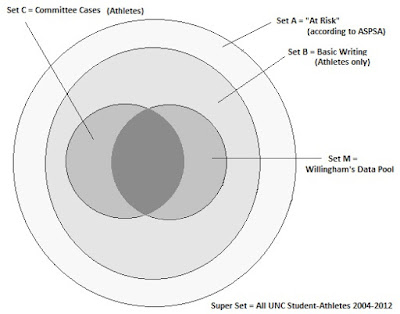In my last blog post, I posed that, whether or not they would agree on how to measure and characterize those student-athletes admitted who were "not-prepared" for UNC-level coursework, both Willingham and Bethel were referring to the same cadre of student-athletes with their concerns.
If you strip away or can ignore Willingham's indelicacy and tendency toward hyperbole, or even the flaws in her analysis that led to her literacy claims, we can deduce that Willingham and Bethel were essentially saying the same thing. By whatever ruler each was using, or however it was each chose to express it, both were concerned about the academic challenge of educating and counseling a particular subset of student-athletes admitted to UNC.
If you convert Willingham's percentages to an absolute number, you can calculate from her claims of 68-70% with reading levels at 8th grade level or below that she was referencing approximately 123-125 total student-athletes over a 9-year period from 2004-2012. (68-70% of 182 or 183.) Since this number had come from a non-random, specific pool of students, already segregated and identified by UNC as being academically "at-risk" upon admission, Willingham's claimed literacy percentages can only be understood as descriptive only of that pool of "at-risk" student-athletes, and not inferential to any other student-athletes not a part of that sub-set as CNN's Ganim, Bradley Bethel and the University itself interpreted it.
Specifically, if Willingham's numbers were assumed to be correct: over a 9-year period, from 2004 to 2012, UNC would have had around 13 reading-challenged student-athletes at UNC per year. That's it. No other student-athletes literacy was implicated. It was just 13 revenue sport (football, men's and women's basketball) student-athletes out of a specific, academically "at-risk" population.
Is this "around 13" per year the same as the "many" in Bethel's email to the new Chancellor? Regardless of just what he meant by academically ill-prepared, how many were the "many" Bethel was talking about?
I think one way to extrapolate a specific number from Bethel's non-specific descriptor is to examine the effect of admissions reforms that answered Bethel's emailed concern. Here are the committee case totals from 2006-2012 -- along with the estimates for 2004 and 2005 estimated -- gathered from UNC's public records, showing an average of 23-24 per year during same period covered by Willingham's claim:
It's logical that Bethel's "many" would come from the approximately 212 committee cases between 2004 and 2012. We know Willingham's data set came from 182-183 cases, drawn from enrollments in freshman Basic Writing, which itself was a subset of what academic counselors dubbed "at risk."
Recall, Bethel's own words corroborate this approximate range per annum:
 |
| Coaching the Mind March 2014 |
The following figure illustrates how all 212 or so of "committee cases" (Set C) and all 182 or so of "Willingham's test group" (Set M) nest within the sets of incoming student-athletes required to take ENG10/100 Basic Writing and the academically "at risk" student-athletes, as defined by ASPSA.
What we don't know (and can't without UNC's cooperation, which could happen if UNC was willing to de-identify the records) is how much of Mary's data set (Set M) intersects with the University's committee cases (Set C) of concern to Bethel. It stands to reason that there'd be a very large overlap, possibly even close to 90-100%. (The figure above makes no attempt to illustrate the degree of overlap and is drawn only for conceptual purposes.)
The post-2013 special-talent committee reforms that had sated Bethel resulted in a reduction of 10-12 special talent admissions requiring committee review per year. Compare that to Willingham's 13/year figure calculated above. If we constructively apply that effect of reform backwards through 2004-2012, we'd get 90-120 student-athletes. If that equates to Bethel's "many", it lines up closely with Willingham's 123-125.
Maybe UNC's admissions reforms have answered the bell, and Willingham - by whatever measure she'd been using - would not find functionally illiterate student-athletes at UNC anymore. But literacy was never the real issue. Willingham's clarion call was for a proper alignment of education with athletics, and the abandonment of academic decisions being made for athletic interests. Reforming special admission policies and procedures is only part of the remedy and doesn't address the issue of athletic interests influencing and corrupting academic goals and priorities. As far as I can tell, Bethel has never conceded that such an alignment shift was necessary or warranted, believing it was never askew. According to him, anything amiss was the fault of the College of Arts & Sciences; not the Athletics Department or the Academic Support Program for Student-Athletes.
The University Provost called Willingham's literacy claims a "travesty." Bethel wrote, "My case has been, and is still, that claiming 70% of men’s basketball and football players read below a high school level is unfair and insulting when the real number is much lower, probably less than 30%. "
Willingham's "70%" of 182 was only 125 total student-athletes, at most; or 12-13 per year. How many football and men's basketball players are admitted each year? 35? 40? Willingham's numbers included women's basketball too as a revenue sport. What's "probably less than 30%" of 40? Hey! There's that number again.
The "travesty" was never Willingham's claims about literacy. The University turned it into a travesty by the way it responded.


